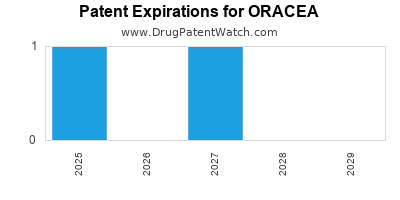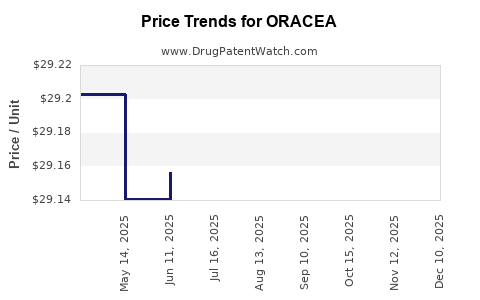ORACEA Drug Patent Profile
✉ Email this page to a colleague
When do Oracea patents expire, and when can generic versions of Oracea launch?
Oracea is a drug marketed by Galderma Labs Lp and is included in one NDA. There are two patents protecting this drug and one Paragraph IV challenge.
This drug has eighteen patent family members in eight countries.
The generic ingredient in ORACEA is doxycycline. There are twenty-eight drug master file entries for this compound. Thirty-six suppliers are listed for this compound. Additional details are available on the doxycycline profile page.
DrugPatentWatch® Litigation and Generic Entry Outlook for Oracea
A generic version of ORACEA was approved as doxycycline by SUN PHARM INDS LTD on November 22nd, 2000.
AI Deep Research
Questions you can ask:
- What is the 5 year forecast for ORACEA?
- What are the global sales for ORACEA?
- What is Average Wholesale Price for ORACEA?
Summary for ORACEA
| International Patents: | 18 |
| US Patents: | 2 |
| Applicants: | 1 |
| NDAs: | 1 |
| Finished Product Suppliers / Packagers: | 2 |
| Raw Ingredient (Bulk) Api Vendors: | 1 |
| Clinical Trials: | 13 |
| Drug Prices: | Drug price information for ORACEA |
| Drug Sales Revenues: | Drug sales revenues for ORACEA |
| Patent Litigation and PTAB cases: | See patent lawsuits and PTAB cases for ORACEA |
| What excipients (inactive ingredients) are in ORACEA? | ORACEA excipients list |
| DailyMed Link: | ORACEA at DailyMed |



Recent Clinical Trials for ORACEA
Identify potential brand extensions & 505(b)(2) entrants
| Sponsor | Phase |
|---|---|
| Wake Forest University Health Sciences | Phase 4 |
| The Skin of Color Society | Phase 4 |
| Derm Research, PLLC | Phase 4 |
Pharmacology for ORACEA
| Drug Class | Tetracycline-class Drug |
Paragraph IV (Patent) Challenges for ORACEA
| Tradename | Dosage | Ingredient | Strength | NDA | ANDAs Submitted | Submissiondate |
|---|---|---|---|---|---|---|
| ORACEA | Delayed-release Capsules | doxycycline | 40 mg | 050805 | 1 | 2008-12-12 |
US Patents and Regulatory Information for ORACEA
ORACEA is protected by two US patents.
| Applicant | Tradename | Generic Name | Dosage | NDA | Approval Date | TE | Type | RLD | RS | Patent No. | Patent Expiration | Product | Substance | Delist Req. | Exclusivity Expiration |
|---|---|---|---|---|---|---|---|---|---|---|---|---|---|---|---|
| Galderma Labs Lp | ORACEA | doxycycline | CAPSULE;ORAL | 050805-001 | May 26, 2006 | AB | RX | Yes | Yes | 8,206,740 | ⤷ Get Started Free | Y | ⤷ Get Started Free | ||
| Galderma Labs Lp | ORACEA | doxycycline | CAPSULE;ORAL | 050805-001 | May 26, 2006 | AB | RX | Yes | Yes | 7,749,532 | ⤷ Get Started Free | Y | ⤷ Get Started Free | ||
| >Applicant | >Tradename | >Generic Name | >Dosage | >NDA | >Approval Date | >TE | >Type | >RLD | >RS | >Patent No. | >Patent Expiration | >Product | >Substance | >Delist Req. | >Exclusivity Expiration |
Expired US Patents for ORACEA
| Applicant | Tradename | Generic Name | Dosage | NDA | Approval Date | Patent No. | Patent Expiration |
|---|---|---|---|---|---|---|---|
| Galderma Labs Lp | ORACEA | doxycycline | CAPSULE;ORAL | 050805-001 | May 26, 2006 | 8,394,406 | ⤷ Get Started Free |
| Galderma Labs Lp | ORACEA | doxycycline | CAPSULE;ORAL | 050805-001 | May 26, 2006 | 9,241,946 | ⤷ Get Started Free |
| Galderma Labs Lp | ORACEA | doxycycline | CAPSULE;ORAL | 050805-001 | May 26, 2006 | 8,603,506 | ⤷ Get Started Free |
| Galderma Labs Lp | ORACEA | doxycycline | CAPSULE;ORAL | 050805-001 | May 26, 2006 | 10,058,564 | ⤷ Get Started Free |
| Galderma Labs Lp | ORACEA | doxycycline | CAPSULE;ORAL | 050805-001 | May 26, 2006 | 7,232,572 | ⤷ Get Started Free |
| Galderma Labs Lp | ORACEA | doxycycline | CAPSULE;ORAL | 050805-001 | May 26, 2006 | 7,211,267 | ⤷ Get Started Free |
| Galderma Labs Lp | ORACEA | doxycycline | CAPSULE;ORAL | 050805-001 | May 26, 2006 | 5,789,395 | ⤷ Get Started Free |
| >Applicant | >Tradename | >Generic Name | >Dosage | >NDA | >Approval Date | >Patent No. | >Patent Expiration |
EU/EMA Drug Approvals for ORACEA
| Company | Drugname | Inn | Product Number / Indication | Status | Generic | Biosimilar | Orphan | Marketing Authorisation | Marketing Refusal |
|---|---|---|---|---|---|---|---|---|---|
| Pfizer Limited | Doxirobe | Doxycycline | EMEA/V/C/000044Treatment of periodontal disease in dogs.Periodontal pocket probing depths >=4 mm are evidence of disease that may be responsive to treatment with the Doxirobe Gel. Use of this product as directed should result in attachment level gains, periodontal pocket depth reductions, local antimicrobial effect and improved gingival health. Noticeable improvements in these parameters should be evident within 2-4 weeks following treatment. The response in individual dogs is dependent on the severity of the condition and rigor of adjunctive therapy. | Withdrawn | no | no | no | 1999-09-16 | |
| >Company | >Drugname | >Inn | >Product Number / Indication | >Status | >Generic | >Biosimilar | >Orphan | >Marketing Authorisation | >Marketing Refusal |
International Patents for ORACEA
See the table below for patents covering ORACEA around the world.
| Country | Patent Number | Title | Estimated Expiration |
|---|---|---|---|
| Australia | 4080897 | ⤷ Get Started Free | |
| Japan | 2002513386 | ⤷ Get Started Free | |
| Canada | 2521885 | FORMULATIONS DE TETRACYCLINES EN DOSE QUOTIDIENNE UNIQUE (ONCE DAILY FORMULATIONS OF TETRACYCLINES) | ⤷ Get Started Free |
| Japan | 5622773 | ⤷ Get Started Free | |
| European Patent Office | 1615622 | FORMULATIONS DE DOXYCYCLINES EN DOSE QUOTIDIENNE UNIQUE (ONCE DAILY FORMULATIONS OF DOXYCYCLINES) | ⤷ Get Started Free |
| Poland | 2204168 | ⤷ Get Started Free | |
| Spain | 2534827 | ⤷ Get Started Free | |
| >Country | >Patent Number | >Title | >Estimated Expiration |
Market Dynamics and Financial Trajectory for ORACEA (Treatment of Rosacea)
More… ↓
Make Better Decisions: Try a trial or see plans & pricing
Drugs may be covered by multiple patents or regulatory protections. All trademarks and applicant names are the property of their respective owners or licensors. Although great care is taken in the proper and correct provision of this service, thinkBiotech LLC does not accept any responsibility for possible consequences of errors or omissions in the provided data. The data presented herein is for information purposes only. There is no warranty that the data contained herein is error free. We do not provide individual investment advice. This service is not registered with any financial regulatory agency. The information we publish is educational only and based on our opinions plus our models. By using DrugPatentWatch you acknowledge that we do not provide personalized recommendations or advice. thinkBiotech performs no independent verification of facts as provided by public sources nor are attempts made to provide legal or investing advice. Any reliance on data provided herein is done solely at the discretion of the user. Users of this service are advised to seek professional advice and independent confirmation before considering acting on any of the provided information. thinkBiotech LLC reserves the right to amend, extend or withdraw any part or all of the offered service without notice.
